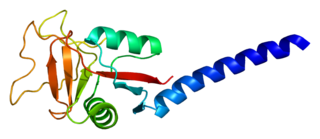
DC-SIGN also known as CD209 is a protein which in humans is encoded by the CD209 gene.

C-type lectin domain family 4 member M is a protein that in humans is encoded by the CLEC4M gene. CLEC4M has also been designated as CD299.

Putative P2Y purinoceptor 10 is a protein that, in humans, is encoded by the P2RY10 gene.

C-type lectin domain family 7 member A or Dectin-1 is a protein that in humans is encoded by the CLEC7A gene. CLEC7A is a member of the C-type lectin/C-type lectin-like domain (CTL/CTLD) superfamily. The encoded glycoprotein is a small type II membrane receptor with an extracellular C-type lectin-like domain fold and a cytoplasmic domain with a partial immunoreceptor tyrosine-based activation motif. It functions as a pattern-recognition receptor for a variety of β-1,3-linked and β-1,6-linked glucans from fungi and plants, and in this way plays a role in innate immune response. Expression is found on myeloid dendritic cells, monocytes, macrophages and B cells. Alternate transcriptional splice variants, encoding different isoforms, have been characterized. This gene is closely linked to other CTL/CTLD superfamily members on chromosome 12p13 in the natural killer gene complex region.

Tetranectin is a protein that in humans is encoded by the CLEC3B gene.

Killer cell lectin-like receptor subfamily B, member 1, also known as KLRB1, NKR-P1A or CD161, is a human gene.

C-type lectin domain family 11 member A is a protein that in humans is encoded by the CLEC11A gene.

Sialic acid-binding Ig-like lectin 9 is a protein that in humans is encoded by the SIGLEC9 gene.

C-type lectin domain family 1 member B is a protein that in humans is encoded by the CLEC1B gene.

Endosialin is a protein that in humans is encoded by the CD248 gene.

C-type lectin domain family 2 member D is a protein that in humans is encoded by the CLEC2D gene.

C-type lectin domain family 4 member A is a protein that in humans is encoded by the CLEC4A gene.

C-type lectin domain family 1 member A is a protein that in humans is encoded by the CLEC1A gene.

C-type lectin domain family 2 member B is a protein that in humans is encoded by the CLEC2B gene.

C-type lectin domain family 12 member A is a protein that in humans is encoded by the CLEC12A gene.

The CD302 antigen also known as C-type lectin domain family 13 member A is a protein that in humans is encoded by the CD302 gene.

C-type lectin domain family 10 member A (CLEC10A) also designated as CD301 is a protein that in humans is encoded by the CLEC10A gene. CLEC10A is part of the C-type lectin superfamily and binds to N-Acetylgalactosamine (GalNAc). It is mainly expressed on myeloid cells and also on oocytes and very early stages of embryogenesis. CLEC10A is used as a marker of the CD1c+ dendritic cell subgroup, also called cDC2. The actions of CLEC10A are diverse, depending on the ligand and environment.

C-type lectin domain family 5 member A (CLEC5A), also known as C-type lectin superfamily member 5 (CLECSF5) and myeloid DAP12-associating lectin 1 (MDL-1) is a C-type lectin that in humans is encoded by the CLEC5A gene.

C-type lectin domain family 4 member F is a protein that in humans is encoded by the CLEC4F gene.

Dectin-2 or C-type lectin domain containing 6A is a protein that in humans is encoded by the CLEC6A gene. Dectin-2 is a member of the C-type lectin/C-type lectin-like domain (CTL/CTLD) superfamily. The encoded protein is a type II transmembrane protein with an extracellular carbohydrate recognition domain. It functions as a pattern recognition receptor recognizing α-mannans and as such plays an important role in innate immune response to fungi. Expression is found on macrophages and dendritic cells. It can also be found at low levels in Langerhans cells and peripheral blood monocytes, where expression levels could be increased upon induction of inflammation.














